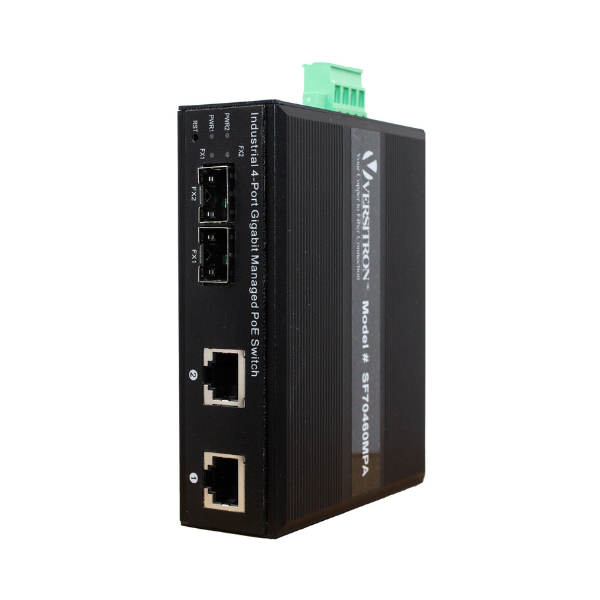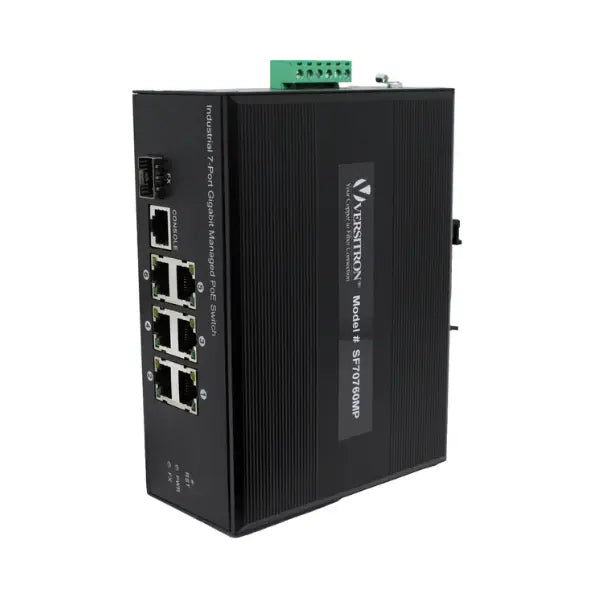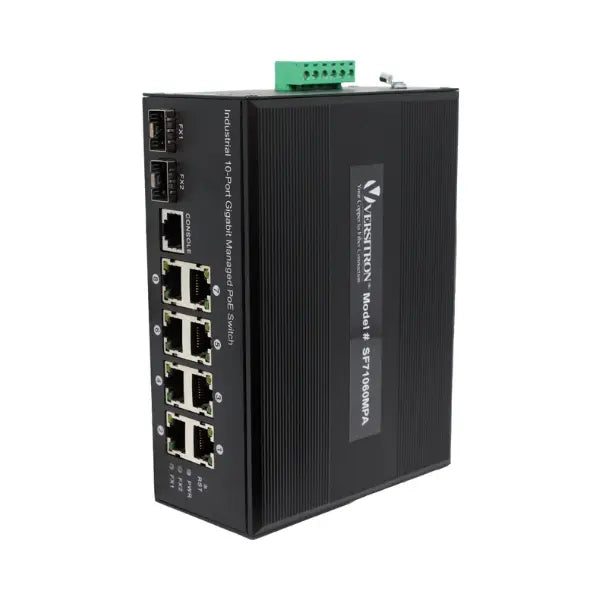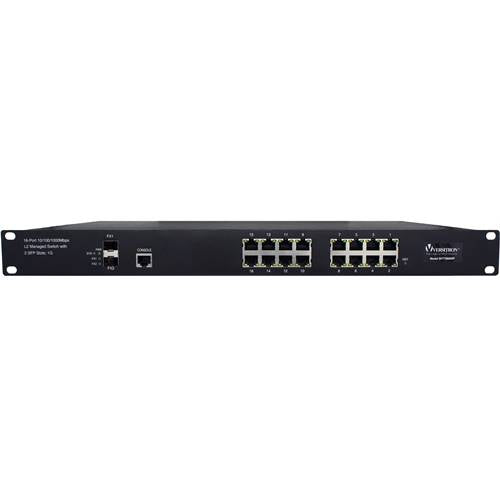Power over Ethernet (PoE) technology finds uses in almost all industrial segments pertaining to business networks. Because it enables data and power transmission over a single cable through separate lines. PoE technology is mainly designed for wired Ethernet as well as fiber optic networks.
Below are the three main PoE standards administered through network switches, each delivering different power levels per port as follows:
- PoE (802.3af) provides up to 15.4 watts of power
- PoE+ (802.3at) provides up to 30 watts of power
- PoE++ (802.3bt) provides up to 100 watts of power
Based on these standards, there are different versions of network switches in use today, such as PoE switches, PoE+ switches, and PoE++ switches.
In this post, we will explore the significant differences between PoE, PoE+, and PoE++ switches.

Difference between PoE vs. PoE+ vs. PoE++ Switch
What is a PoE Switch?
Power Over Ethernet Switch can deliver power to PDs (Powered Devices) via Ethernet cables, facilitating network connectivity. These switches support a maximum power consumption of up to 15.4W per PoE port, with a voltage range between 44V and 57V. Typically, the voltage range of PDs connected to the PoE switch spans from 37V to 57V.
PoE switches come in various configurations, ranging from small, unmanaged switches suitable for home or small office use to large, PoE powered managed switches designed for enterprise-level networks.
Also read: How Does a PoE Switch Work?
What is a PoE+ Switch?
A PoE+ switch is a network switch designed to support the IEEE 802.3at standard. Compared to the original PoE (802.3af) standard, a PoE+ switch delivers up to 30W of power. PoE+ voltage ranges from 50V to 57V.
PoE+ network switches are also backward-compatible, meaning they can support devices that operate under the PoE standard.
What is a PoE++ Switch?
A PoE++ switch is a network switch based on the latest PoE standard, IEEE 802.3bt, which is classified into two types: PoE++ Type 3 and PoE++ Type 4. A PoE++ Type 3 switch can deliver up to 60 watts of power per port, while a PoE++ Type 4 switch can provide up to 100 watts per port.
PoE++ network switches are generally used for setting up management systems and making long-distance calls.
In summary, the main differences between PoE+ and PoE++ are the power they deliver, the number of twisted-pair wires they use, and the IEEE standards they follow. PoE and PoE+ use two pairs of twisted-pair wires, whereas PoE++ utilizes all four pairs. In terms of standards, PoE follows the IEEE 802.3af standard, PoE+ adheres to IEEE 802.3at, and PoE++ is based on the IEEE 802.3bt standard.
PoE, PoE+, and PoE++ Switches Specifications
The below chart summarizes detailed specifications of PoE vs PoE+ vs PoE++ switches.
|
|
PoE |
PoE+ |
PoE++ |
|
PoE Type |
Type 1 |
Type 2 |
Type 3,4 |
|
Switch Port Power |
|||
|
Maximum Port Power |
15.4 W |
30W |
60W, 100W |
|
Port Voltage Range |
44-57V |
50-57V |
52-57V |
|
Powered Device Power |
|||
|
Voltage Range to Device |
37-57V |
42.5-57V |
42.5-57V, 41.1-57V |
|
Max Power to Device |
12.95W |
25.5W |
51W, 71W |
|
Cables |
|||
|
Twisted Pairs Used |
2-pair |
2-pair |
2 Pair or 4 Pair, 4 Pair |
|
Cable Types Supported |
Cat3/Cat 5 |
Cat5 |
Cat 5, Cat 5 |
|
IEEE Standards |
|||
|
IEEE Standard |
IEEE 802.3af |
IEEE 802.3at |
IEEE 802.3bt, IEEE 802.3bt |
Note: The figures presented are theoretical values. In practice, the total power capacity of PoE series switches will be oversubscribed with more ports, as many devices use less than the maximum power.
Applications of PoE Switches, PoE+ Switches, and PoE++ Switches
PoE, PoE+, and PoE++ switches can be used to power a wide range of surveillance as well as audio-visual equipment in commercial facilities. This section offers a few common application examples of each of these switches.
PoE switches are ideal for powering the following:
- VoIP phones operated across offices
- Pool pumps, cameras, lighting installations, and digital signage on the sides and tops of skyscrapers
- Audio visual equipment in stadium and indoor spaces
- Wireless access points for small networks, RFID readers, wireless network repeaters
- Stationary cameras as well as cameras with no PTZ features
- Solar power equipment in commercial and industrial spaces
Note: PoE switches are not recommended for data transfer over long distances or in applications where ambient temperature conditions may be present. Both these factors can have an impact on these switches.
PoE+ Switches are ideal for powering the following:
- Office or home alarm systems
- Biometric sensors
- Motion tracking cameras installed in commercial premises
- Remotely managed PTZ cameras
- Remote computer terminals
- IP telephones for voice calls, text messaging, and fax
PoE++ Switches are ideal for powering the following applications:
- Video telephones
- Thin clients (small computer)
- Door access systems or gate controllers
- Remote patient monitoring devices
Versitron PoE Switches
| Model | Description | View Details |
| SF70460MP | 2-Ports 10/100/1000 Ethernet, 2-100/1000 SFP | |
| SF70760MP | 6-Ports 10/100/1000 Ethernet, 1-100/1000 SFP | |
| SF71060MPA | 8-Ports 10/100/1000 Ethernet, 2-100/1000 SFP | |
| SF71860MP | 16-Ports 10/100/1000 Ethernet, 2-100/1000 SFP | |
| SG71060MPB | 8-Ports 10/100/1000 Ethernet, 2-100/1G SFP, 250W PoE/PoE+ | |
| SG72060MP | 16-Ports 10/100/1000 Ethernet, 4-100/1G SFP, 400W PoE/PoE+ | |
| SGX72870MPA | 24-Ports 10/100/1000 Ethernet, 4-1G/10G SFP, 600W PoE/PoE+ | |
| SGX75270MP | 48-Ports 10/100/1000 Ethernet, 4-1G/10G SFP, 600W PoE/PoE+ |
Conclusion
As PoE technology evolves from PoE to PoE+ and then to PoE++ to fulfill growing power requirements, we have seen that network switches equipped with PoE have also been upgraded from PoE switches to PoE+ switches, and finally to PoE++ switches. In this blog post, we discuss the significant differences between these switches as well as their applications. We hope this post will help you choose a suitable PoE network switch for your desired application.
Furthermore, it is essential to source them from authorized and certified manufacturers and suppliers. VERSITRON is one of the leading and trustworthy manufacturers and providers of PoE switches, which support Ethernet, Fast Ethernet, and Gigabit Ethernet. They are designed for both industrial and commercial applications.









